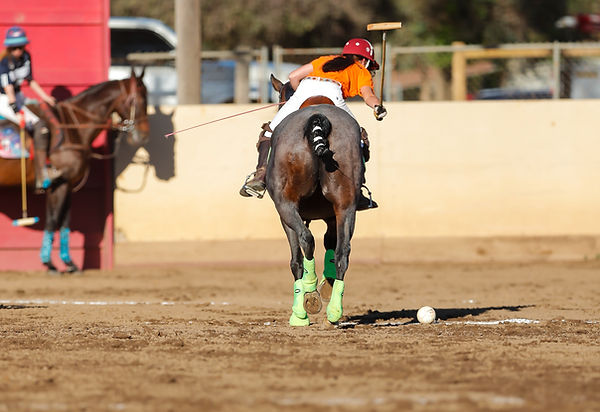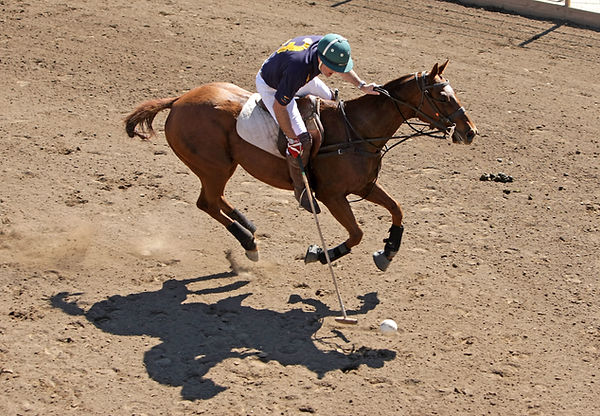POWAY POLO CLUB
San Diego, California
POLO
A game of polo is played by two teams with the intent of scoring "goals" by hitting the ball with a mallet while mounted on horse back through the opposing team's goal. Each team in grass polo has four players participating on a field approximately the size of three football fields. A game consists of periods called "chukkers". Each chukker is 7 minutes and an entire game is comprised of 4 to 8 chukkers.
Arena polo has similar rules to grass polo though is played with three players per team. The playing area is smaller, enclosed, and consists of compacted sand or dirt surface. Arena polo entails more more maneuvering, quicker turns, and changes of direction due to smaller playing surface.
The rules governing the game of polo are intended for the safety of both the players and horses. Organized games are monitored by umpires, a whistle is blown when an infraction occurs, and penalties are given. Strategic play in a game of polo are based on the "line of the ball". The line of ball is an imaginary line that extends through the ball in the line of travel both forward and backward from the current position of the ball. The line of the ball defines rules for players to approach the ball safely and execute plays during chukkers. The "line of the ball" changes each time the ball changes direction after a player hits the ball. The player who hits the ball in most cases has the right of way, and other players cannot cross the line of the ball in front of the player.
Players approaching the ball will ride on either side of the line of the ball giving each access to the ball. A player can cross the line of the ball when it does not create a dangerous situation. This situation is defined by distance, time, and angle. These three components must be determined to allow safe play in order for a player to cross the line and not incur a penalty while doing so. Most infractions and penalties are related to players improperly crossing the line of the ball or the right of way. A secondary component of line of ball is right of way. When a player has the line of the ball on his or her right side, they have the right of way. Right of way will determine which player has priority to the ball in terms of making a play on the ball.
The defending player has a variety of opportunities for his team to gain possession of the ball. He or she can push the opponent off the line or steal the ball from the opponent. Pushing the opposing player off the line is called a "ride off". A ride off is when the player will meet the opposing player knee to knee and make contact with the opposing player's horse. Another common defensive play is called "hooking." While a player is taking a swing at the ball, an opponent can block the swing by using their mallet to hook the mallet of the player swinging at the ball. A player may hook only if they are on the side where the swing is being made. A player may not purposely touch another player, tack, or pony with their mallet. The official set of rules and rules interpretations are reviewed and published annually by each country's polo association. Most of the smaller associations follow the rules of the Hurlingham Polo Association the national governing body of the sport of polo in the United Kingdom, and the United States Polo Association.
The horses used in the sport of are called "polo ponies". The term pony is a traditional name and the mounts are actually a full-sized horse. They range from 14.2 to 16 hands high and weigh 900–1,100 pounds. The polo pony is selected on the basis for quick bursts of speed, stamina, agility and handiness. Temperament is critical as the horse must remain responsive under pressure and not become excited or difficult to control. Many polo ponies are Thoroughbreds or Thoroughbred crosses due to their speed and agility. Polo ponies are trained to be handled with one hand on the reins termed neck reining. The polo pony is trained to respond to the rider's leg and weight cues for moving forward, turning, and stopping. Polo pony training generally begins at age of three and lasts from about six months to two years. Most horses reach full physical maturity at about age five, and ponies are at their peak of athleticism and training are around ages 6 to 10. However, without any accidents, polo ponies may have the ability to play until they are 18 to 20 years of age.
Polo players on a teams is assigned a position with certain responsibilities. The positions are numbered one through four for the grass game. No names are assigned to each position on a polo teams. The basic duties of the players are as follows: Number One player is the most offensive player on the team and can be one of the most difficult positions to play. The number one has the main objective of scoring goals. The Number One needs anticipation, determination, and self-control, being theoretically responsible for scoring goals and neutralizing the opposing Number Four (defensive player). Number Two is hustling and scrambling during a chukker always trying to get control of the ball. The Number Two needs to be extremely maneuverable, optimistic, and aggressive nature. Number Three, who plays the "quarterback". The Number Three is ideally a powerful hitter and tactical leader. Number Three feed balls up to Number One and Number Two, but also help maintain a solid defense. Number Four is primarily a defensive player, who may move anywhere on the field, mainly functions to prevent scoring. Number Four will typically mark the opposing teams Number One and not allow any player behind them on the field of play.
Polo player's are rated in a handicap system from 0 to 10 goals according to their abilities in competition. The higher the goal rating, the higher caliber of a player. The goal ranking is based on horsemanship, hitting ability, knowledge of the game, quality of horses, and sportsmanship. The goal rankings of a player in the United States is governed by the United States Polo Association. Separate rankings are given to player's for both arena and grass polo.
A player will wear a protective helmet, riding boot, knee pads, and jersey bearing the number of their position during competitions. The mallet has a wrapped grip around a bamboo cane shaft and bamboo head 9.5 inches in length. The mallets weigh 165-195 grams and varying in length from 48 to 53 inches. The ball is struck with the side of the mallet, not the end. Polo saddles are English-style with deep seats. The polo pony’s front legs are wrapped from just below the knee to the ankle to prevent injury, the mane is clipped and the tail braided to prevent interference with the mallet swing.




